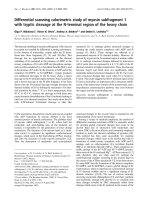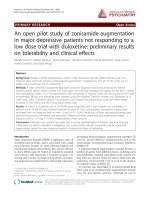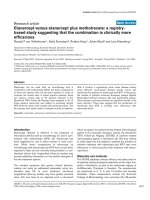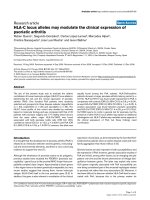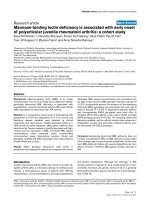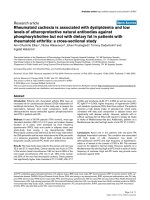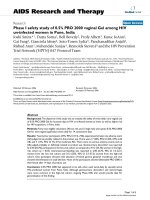Báo cáo y học: "UK pneumonectomy outcome study (UKPOS): a prospective observational study of pneumonectomy outcome" pot
Bạn đang xem bản rút gọn của tài liệu. Xem và tải ngay bản đầy đủ của tài liệu tại đây (264.4 KB, 8 trang )
BioMed Central
Page 1 of 8
(page number not for citation purposes)
Journal of Cardiothoracic Surgery
Open Access
Research article
UK pneumonectomy outcome study (UKPOS): a prospective
observational study of pneumonectomy outcome
Ellie S Powell
1
, Adrian C Pearce
2
, David Cook
3
, Paul Davies
1
, Ehab Bishay
1
,
Geoffrey MR Bowler
4
, Fang Gao*
1
and UKPOS Co-ordinators
Address:
1
Heart of England NHS Trust, Birmingham, UK,
2
Guy's and St Thomas' NHS Trust, London, UK,
3
University Hospitals Birmingham NHS
Trust, Birmingham, UK and
4
Royal Infirmary Edinburgh, Edinburgh, UK
Email: Ellie S Powell - ; Adrian C Pearce - ; David Cook - ;
Paul Davies - ; Ehab Bishay - ;
Geoffrey MR Bowler - ; Fang Gao* - ; UKPOS Co-ordinators -
* Corresponding author
Abstract
Background: In order to assess the short term risks of pneumonectomy for lung cancer in
contemporary practice a one year prospective observational study of pneumonectomy outcome
was made. Current UK practice for pneumonectomy was observed to note patient and treatment
factors associated with major complications.
Methods: A multicentre, prospective, observational cohort study was performed. All 35 UK
thoracic surgical centres were invited to submit data to the study. All adult patients undergoing
pneumonectomy for lung cancer between 1 January and 31 December 2005 were included. Patients
undergoing pleuropneumonectomy, extended pneumonectomy, completion pneumonectomy
following previous lobectomy and pneumonectomy for benign disease, were excluded from the
study.
The main outcome measure was suffering a major complication. Major complications were defined
as: death within 30 days of surgery; treated cardiac arrhythmia or hypotension; unplanned intensive
care admission; further surgery or inotrope usage.
Results: 312 pneumonectomies from 28 participating centres were entered. The major
complication incidence was: 30-day mortality 5.4%; treated cardiac arrhythmia 19.9%; unplanned
intensive care unit admission 9.3%; further surgery 4.8%; inotrope usage 3.5%. Age, American
Society of Anesthesiologists physical status ≥ P3, pre-operative diffusing capacity for carbon
monoxide (DLCO) and epidural analgesia were collectively the strongest risk factors for major
complications. Major complications prolonged median hospital stay by 2 days.
Conclusion: The 30 day mortality rate was less than 8%, in agreement with the British Thoracic
Society guidelines. Pneumonectomy was associated with a high rate of major complications. Age,
ASA physical status, DLCO and epidural analgesia appeared collectively most associated with major
complications.
Published: 30 July 2009
Journal of Cardiothoracic Surgery 2009, 4:41 doi:10.1186/1749-8090-4-41
Received: 19 May 2009
Accepted: 30 July 2009
This article is available from: />© 2009 Powell et al; licensee BioMed Central Ltd.
This is an Open Access article distributed under the terms of the Creative Commons Attribution License ( />),
which permits unrestricted use, distribution, and reproduction in any medium, provided the original work is properly cited.
Journal of Cardiothoracic Surgery 2009, 4:41 />Page 2 of 8
(page number not for citation purposes)
Background
Pneumonectomy is a valuable surgical option for anatom-
ically resectable non-small cell lung cancer when a wedge
resection, lobectomy or other lesser resection will not
clear the tumour. However, pneumonectomy for lung
cancer is associated with significant morbidity and mor-
tality. There have been conflicting findings concerning the
important risk factors for poor outcomes following a
pneumonectomy.[1-10]
In this prospective, multi-centre observational cohort
study of UK pneumonectomy outcome (UKPOS) we
examined current UK anaesthetic and surgical practice for
pneumonectomy, investigated rates of major complica-
tions, in-hospital and 30-day mortality rates, and their
risk factors.
Methods
Study centres
Having obtained Multi-centre Research Ethics Committee
approval, all thoracic centres (n = 35) across the UK were
invited to submit pneumonectomy data. The Research
and Development Directorates in 28 centres were willing
to participate and obtained Site Specific Approval. Each
thoracic centre had a Principal Investigator (PI) responsi-
ble for collecting and entering the data on an anonymous
UKPOS data sheet and submitting it to the Data Centre at
Birmingham Heartlands Hospital, England. The PI was
responsible for ensuring as many patients were recruited
as possible and for following-up the study patients for 30
days.
Study participants
All adult patients (>18 years of age) undergoing elective
pneumonectomy for lung cancer from 1
st
January to 31
st
December 2005 were eligible for inclusion in the study.
We included those patients for whom pneumonectomy
was the intended primary procedure and those who were
scheduled for more limited lung resection but had on-
table conversions to pneumonectomy. We excluded
patients undergoing pleuropneumonectomy, extended
pneumonectomy, completion pneumonectomy follow-
ing previous lobectomy and pneumonectomy for benign
disease.
Data collection
Data were collected prospectively using identical data col-
lection sheets with over 50 essential fields (Additional file
1: Data collection sheet). Accompanying material defined
each field to establish conformity amongst the reporting
centres. When a patient's data were complete they were
transmitted by the PI in anonymous format to the Data
Centre and checked for obvious errors. The minimum pre-
dicted post-operative (ppo) values for forced expiratory
volume in one second (FEV
1
) and carbon monoxide dif-
fusing capacity (DLCO) were calculated using the follow-
ing formula: preoperative value in percent × number of
segments remaining/19 (total). A separate communica-
tion contained patient identifiers, where written consent
had been obtained, and these data were passed to the
Office for National Statistics for long-term follow-up.
Outcomes after pneumonectomy
For the assessment of outcome, the end point was a
patient suffering a major complication. This was defined
as any of the following: treated cardiac arrhythmias,
unplanned intensive care admissions, further surgery, ino-
trope usage, or 30 day mortality.
Statistical analysis
Summary statistics quoted are medians and ranges as
many characteristics discussed have skew-distributions.
Subgroup comparisons used Mann-Whitney tests or other
non-parametric tests. Categorical data were compared by
Chi-squared or Fisher exact tests as appropriate. Stepwise
logistic regression, as implemented in SPSS 15.0, was used
to determine odds ratios and 95% confidence intervals for
variables between patients with and without post-opera-
tive major complications and to explore the multi-factor
association with all observed risk factors.
Results
Characteristics of Thoracic Centres and the patients
Four of 28 centres with Site Specific Approval did not per-
form any pneumonectomies during the study period. The
Data Centre received datasheets from 24 UK thoracic sur-
gical centres (range 2–38 pneumonectomies/centre), of
which 12 centres (50%) performed more than 10 pneu-
monectomies in 2005. Data were collected for 312
patients who had elective pneumonectomies for lung can-
cer from 1
st
January to 31
st
December 2005. The Society of
Cardiothoracic Surgeons of Great Britain returns for
2005–2006 recorded 416 pneumonectomies for primary
lung cancer, but this number would include completion
or extended pneumonectomies not relevant to our
study.[11] Our data capture of 312 pneumonectomies
therefore represents at least 75% of the UK case load in
that year. Analysis of variation between centres using the
Mantel-Haenszel method revealed that centres were not
homogeneous in respect of several surgical and patient
characteristics considered here. However having captured
such a large part of UK case load, we view this as represent-
ing UK practice and only discuss the centres here as a col-
lective.
As shown in Table 1, two-thirds of patients were male, and
they were older and heavier smokers than female patients.
Out of 310 patients with known American Society of
Anesthesiology (ASA) Physical Statuses, the majority
(94%) were ≥ ASA P2 (P2-53.1, P3-40.6 and P4-3.5%).
Journal of Cardiothoracic Surgery 2009, 4:41 />Page 3 of 8
(page number not for citation purposes)
Most patients (69%, n = 215) had tumours staged IIb and
less and 10.6% (n = 33) patients received neo-adjuvant
chemo- or radiotherapy.
Preoperative cardiopulmonary function
Table 1 lists the baseline pulmonary function test results
of the study group. 261 of 312 (83.7%) patients had pre-
operative oxygen saturation on air measured. 235
(75.3%) had oxygen saturations more than 95%, 22
(7.1%) were within 90–94%, 4 (1.3%) were less than
90%, and 51 were unknown (16.3%).
Intra-operative management
Right-sided operations were performed in 35.3% (n =
110) of patients. Pneumonectomy took a median of 150
(55–600) minutes to complete, and 32.7% (n = 102) of
operations were on-table conversions from lobectomy to
pneumonectomy. The majority of surgeons used a sta-
pling device to close the bronchial stump (n = 249,
87.1%) compared to a hand sewn suture technique (n =
37, 12.9%). The median of 233 recorded blood losses was
350 mls ranging from 50 to 5,500 mls and thirty-five
patients (11.4%) were transfused (250–1500 mls).
The mean duration of one-lung ventilation was 120 (40–
540) minutes and this was approximately two-thirds of
the total duration of operative mechanical ventilation.
56.8% (n = 168) of anaesthetists used volume-controlled
ventilation as opposed to pressure controlled ventilation.
However, there was no noteworthy difference in the per-
centage of patients ventilated with plateau inspiratory
pressures ≥ 25 cm H
2
O between the two modes.
Data on pain relief of 306 patients demonstrated that tho-
racic epidural was the most popular pain control tech-
nique (61.1%), followed by paravertebral block (31%). In
a few cases paravertebral was combined with intrathecal
morphine (1.3%). Other techniques included intrathecal
morphine (1.6%), patient controlled analgesia (4.9%)
and intermittent injections or infusions of opioids
(1.3%). At the end of surgery, 95.2% (n = 275) of patients
had intercostal chest drains inserted.
Post-operative management
Data on the post-operative management location of 308
patients (98.7%) were available. The majority were post-
operatively managed on critical care areas (88.1%)
although 10.6% were post-operatively managed on surgi-
cal wards (11.8% data unknown). Of the 44 ICU admis-
sions, 27 were unplanned. The median fluid balance at 24
hours was +16.2 ml/kg (-42.3 to 87.6 ml/kg).
Outcome following pneumonectomy
A total of 133 major complications occurred in 99 of 312
patients (31.7%). Table 2 shows the frequency of the indi-
vidual components of the major complications.
Table 1: Characteristics of the patients
Male (n = 209) * Female (n = 101)*
Median (range)
Age (years) 65 (30–86) 59 (36–80)
Weight (kg) 78 (49–116) 63 (40–112)
Body Mass Index 25.4 (16.6 – 37.0) 25.1 (18.0 – 41.0)
Smoking history (pack-yr) 40 (5–250, n = 172) 35 (4–420, n = 81)
*gender of two cases not recorded
Pathological tumour stage % (n)
IA 5.1 (15)
IB 35.9 (106)
IIA 4.4 (13)
IIB 27.5 (81)
IIIA 21.7 (64)
IIIB 5.4 (16)
Total of 295 recorded
Pulmonary function tests Number of patients Median (range)
Forced expiratory volume
1
(FEV
1
) L 309 2.2 (0.5 – 4.1)
FEV
1
/Forced vital capacity (FVC) % 294 69 (37 – 100)
FEV
1
% predicted 308 78 (17.3 – 130.8)
Minimum ppo FEV
1
% predicted 306 39.3 (8.1 – 69.3)
DLCO mmol/min/kPa 153 5.8 (0.8 – 12.6)
DLCO % predicted 163 70 (29 – 136)
Minimum ppo DLCO % predicted 163 35.7 (15.3 – 71.6)
Continuous walking distance on flat without stopping, metre 238 1,500 (4–15,000)
Journal of Cardiothoracic Surgery 2009, 4:41 />Page 4 of 8
(page number not for citation purposes)
Developing a major complication resulted in an increased
median length of hospital stay of an additional 2 days (8
(4–23) days vs. 10 (1–63) days).
The overall 30 day and in-hospital mortality rates after
pneumonectomy were 5.4% (n = 17) and 4.8% (n = 15),
respectively. Respiratory causes accounted for 58.8% of 30
day mortality (pneumonia, n = 3; pneumonia following
broncho-pleural fistula, n = 2; acute respiratory distress
syndrome, n = 3; pulmonary aspiration, n = 1; and respi-
ratory failure, n = 1). Major haemorrhage accounted
for 23.5% (n = 4) and myocardial infarction for 17.6%
(n = 3).
Risk factors for major post-operative complications
In univariate analysis, preoperative oxygen saturation less
than or equal to 94% and FEV
1
were associated with major
complications, (Table 3).
Stepwise multiple logistic regression analysis showed that
advanced age, high ASA Physical Status and epidural anal-
gesia were statistically significant associates of major com-
plications at p < 0.05 (Table 4). In the roughly 50% of
cases for which DLCO was recorded, low DLCO was also
strongly associated.
The risk of developing a major complication increased
throughout the age ranges in the study, (Figure 1).
Discussion
Principal Findings
The short term risks of pneumonectomy as demonstrated
by this UK study were; in-hospital and 30-day mortality
rates of 4.8% and 5.4% respectively, and rates of major
complications of 31.7%.
This rate of major complications is in agreement with
published data (range 17–47%).[1,2,4,6,12] Treated car-
diac arrhythmias were the commonest major complica-
tion affecting 19.9% (n = 62) of patients. This is also
consistent with published data (range 16.5–
26.1%).[1,2,4,6].
Increasing age, higher ASA Physical Status, preoperative
reduced DLCO values and epidural analgesia were all
found to contribute to risk factors collectively associated
with an increased rate of major complications.
Strengths and limitations
Previous studies on pneumonectomy outcome have often
used small numbers of pneumonectomies, [1-5] been ret-
rospective,[6,7,9,13-15] or carried out over prolonged
periods of time .[6-10] Consequently there have been
conflicting findings concerning the important risk factors
for poor outcomes following a pneumonectomy.
Table 2: Frequency of individual components of the major
complications
Major complications n (%) of patients
Treated cardiac arrhythmias 62 (19.9)
Unplanned ICU admissions 28 (9.0)
30 day mortality 17 (5.4)
Further surgery 15 (4.8)
Inotrope usage 11 (3.5)
Table 3: Risk factors associated with major complications in univariate analysis
Risk factors Numbers Odds ratio (95%CI)
Age 312 1.07 (1.03, 1.10; P < 0.001)
ASA: ≥ P3 vs < P3 137, 173 1.9 (1.1, 3.0; P = 0.01)
DLCO mmol/min/kPa 153 0.76 (0.62, 0.92; P = 0.006)
Epidural vs paravertebral 187,90 1.8 (1.0,3.2; P = 0.05)
FEV
1
L 309 0.67 (0.45, 1.00; P = 0.05)
FEV
1
% predicted 308 1.00 (0.98,1.01; P = 0.7)
ppo FEV
1
% predicted 306 0.99 (0.96,1.01; P = 0.4)
DLCO % predicted 154 0.99 (0.97,1.01; P = 0.13)
ppo DLCO % predicted 162 0.97 (0.93,1.01; P = 0.11)
Preop. O2 saturation on air: ≤ 94 vs > 94% 26, 235 2.3 (1.0, 5.2; P = 0.04)
One lung ventilation: (hours) 294 1.09 (0.99, 1.20; P = 0.1)
Plateau pressure during one lung ventilation: ≥ 25 vs < 25 cmH
2
O 254 1.5 (0.8, 2.7; P = 0.2)
Right vs left operations 110, 199 1.5 (0.9, 2.5; P = 0.08)
Fluid positive balance 272,19 0.9 (0.3, 2.5; P = 0.9)
Planned vs Converted 208,102 1.3 (0.8,2.2; P = 0.3)
Gender: Male vs Female 209,101 1.2 (0.7,2.0; P = 0.4)
Stump closure: staples vs sutures 249,36 1.1 (0.5,2.3; P = 0.9)
Smoking history: yes vs no 286,25 1.2 (0.5,3.0; P = 0.7)
Neo-adjuvant therapy: yes vs no 33,270 0.5 (0.2,1.1; P = 0.1)
Journal of Cardiothoracic Surgery 2009, 4:41 />Page 5 of 8
(page number not for citation purposes)
The main strength of this study is that it is the largest pro-
spective investigation into morbidity and mortality fol-
lowing elective pneumonectomy for cancer, and therefore
the findings are representative of current UK practice. The
Society of Cardiothoracic Surgeons of Great Britain
returns for 2005 – 2006 recorded 416 pneumonectomies
for primary lung cancer, but this number would include
completion or extended pneumonectomies not relevant
to our study.[11] Our data capture of 312 pneumonecto-
mies represents at least 75% of the case load performed in
the UK in a calendar year. Another strength of this study is
that it was carried out over one calendar year to minimise
variations in clinical practice over time.
The main limitation of this study is due to its observa-
tional nature and therefore observations on risk factors for
poor outcome may be subject to unknown bias of various
kinds. However because the data represent such a large
portion of UK practice in this area, it is of interest to see
the factors apparently most important though the results
must be interpreted with some caution.
Interpretation of risk factors for major complications in
the context of previous studies
1) Age
Based on Grade B evidence, the British Thoracic Society
(BTS) guidelines state that age should be a factor in decid-
ing on suitability for pneumonectomy and that mortality
should be less than 8%.[16] The American College of Car-
diology and American Heart Association (ACC/AHA)
practice guideline update on perioperative cardiovascular
evaluation for noncardiac surgery 2002 indicates that
patients who are 70 years or older undergoing major tho-
racic surgery carry a particularly high risk for perioperative
cardiac morbidity.[17]
The median age of our study population was 63 years
which is consistent with the median age (58–65 years) in
current publications on patients undergoing elective
pneumonectomy for lung cancer.[1,2,4,6,9,12,18,19] The
incidence of lung cancer peaks in people in their late 70s
and is 3.3-fold higher in the 70–80 year than the 60–70
year age group,[10,20] which indicates that age is one fac-
tor used worldwide to minimize poor outcome following
lung surgery. A number of studies demonstrate that
advanced age is a strong predictor of morbidity and/or
mortality following lung resection,[10,15,21-23] and
pneumonectomy[1,6,18]. A small amount of evidence
supports no association between advanced age and mor-
bidity.[2,14] Our study not only shows a significant dif-
ference in age between the groups suffering or not-
suffering a major complication including death, but also
shows the risk increases in a stepwise manner across the
quartiles. Patients older than 62 years had up to a 5-fold
increase in the rate of major complications. This quantita-
tive analysis of the relationship has a notable implication
on future selection of patients with lung cancer for pneu-
monectomy. In the United States, it is conceivable that the
number of persons older than 65 years undergoing tho-
racic and other major non-cardiac surgery will increase
Table 4: Risk factors associated with major complications in multivariate analysis
Multivariate (n = 275) DLCO included (n = 141)
Risk factors Odds ratio (95%CI) Odds ratio (95%CI)
Age 1.07 (1.04, 1.11; P = 0.001) 1.07 (1.02, 1.11; P = 0.004)
ASA: ≥ P3 vs < P3 1.7 (1.0, 2.9; P = 0.05)
DLCO mmol/min/kPa 0.78 (0.64, 0.95; P = 0.02)
Epidural vs paravertebral 2.2 (1.1, 3.8; P = 0.02)
Figure 1
Journal of Cardiothoracic Surgery 2009, 4:41 />Page 6 of 8
(page number not for citation purposes)
from the current 6 million to nearly 12 million per
year.[17] Hence, limiting an effective surgical procedure
to the proven low risk age group cannot be the only way
to improve post-operative outcomes.
2) ASA Physical Status
This study has shown that an ASA Physical Status of more
than or equal to P3 is associated with poor outcome.
Despite its widespread clinical use, the value of the ASA
Physical Status as a predictor for lung resection outcome
has only been investigated in a couple of studies, which
have shown it to predict both morbidity[24] and mortal-
ity.[9] Licker et al found it to be significant at predicting
mortality in univariate analysis but not multivariate.[12]
Although the ASA Physical Status is a subjective assess-
ment made by the Anaesthetist, it is based on many
patient factors including co-morbidities and exercise
capacity, which may explain why it is significant in pre-
dicting major complications.
3) Lung function
The British Thoracic Society recommend that if the FEV
1
is
more than 2 litres, in the absence of interstitial lung dis-
ease or unexpected shortness of breath, further respiratory
function tests are not required to assess suitability for
pneumonectomy.[16] Our study found that the FEV
1
had
a marginally significant association with major complica-
tions in univariate but not multivariate analysis. However,
we did not find any suggestion of association between the
percent predicted FEV
1
or the minimum post-operative
percent predicted value (ppo) with major complications.
The study median minimum post-operative percent pre-
dicted FEV
1
was 39.3%, which indicates that the absence
of an association was not due to high overall values. Per-
haps the reason that our study failed to suggest an associ-
ation was because patients with low ppo FEV
1
values were
then carefully selected for surgery as recommended by the
British Thoracic Society guidelines[16]. Evidence from the
literature is conflicting concerning the usefulness of FEV
1
values as risk factors. Although FEV
1
and its determinants
have been found to predict morbidity or mortality in uni-
variate analysis,[6,21,24,25] only a few studies have
found it to contribute as predictor of morbidity or mortal-
ity in multivariate analysis.[5,26,27] Further studies have
not found any association between FEV
1
variables and
morbidity or mortality.[1,2,4,12] This conflicting evi-
dence is probably explained by variations in practice once
a low FEV
1
value is identified, in terms of further assess-
ment and management. A limitation of this study is that
the ppo FEV
1
values were calculated without a ventilation/
perfusion scan and termed minimum values in the text.
For the 49% of cases for which it was measured, the DLCO
was a significant predictor of complications post-pneu-
monectomy but it was the raw DLCO measurement that
was significant rather than the adjusted DLCO expressed
as a percentage of predicted normal. Diffusing capacity
declines with age, and age is one factor within the calcula-
tion of DLCO percent predicted normal. Elderly patients
will, therefore, have low absolute DLCO values which will
correct favourably as percent predicted normal for a
patient of that age. This suggests that a critical amount of
diffusion capacity is required to undergo pneumonec-
tomy without complication. Diffusing capacity is not
measured as routinely as spirometry prior to lung resec-
tion, a finding that Ferguson et al have challenged with
studies showing that not only is it the best single predictor
of complications, but also that it remains the best predic-
tor for patients with normal spirometry.[21,28] However,
Ferguson et al found that it was the post-operative pre-
dicted DLCO that was important and not the raw value.
This difference may be because they studied all lung resec-
tions where as our study was limited to pneumonectomy.
However our results support the view that diffusing capac-
ity should be measured more frequently and the value
used in the risk assessment to determine suitability for
pneumonectomy.
4) Fluid balance
Previous studies by Licker et al.[25] and Alam et al[29]
have found a clear link between fluid therapy and inci-
dence of post-lung resection acute lung injury (ALI). We
found no such link between fluid therapy and major com-
plications. The positive fluid balances in our group were
small with the complication group having a median fluid
balance of 20 ml/kg at 24 hours. Our results may be seen
as confirming the 'beneficial' effect of thoracic anaesthet-
ists keeping to current recommendations for fluid therapy
post-pneumonectomy. However there were a number of
wayward fluid balances reported and no obvious ill-
effects from this in the small number of patients reported.
This supports the contention that excessive fluid adminis-
tration exacerbates hypoxemia in patients who develop
ALI, but does not initiate the lung injury.
5) Side of surgery
Most evidence supports increased complications and
mortality following right sided lung resec-
tions[4,7,18,27,30,31] which is partially explained by an
increased risk of broncho-pleural fistulae. However, oth-
ers have found no significant difference.[2,6,12] This
might be because of the limited power of smaller studies
or the difficulty with analyzing data collected over many
years. In our large study, the proportion of right-sided sur-
gery was 35.3%, which might indicate that side of surgery
is used to determine suitability for surgery. Our study
found a higher complication rate (38%) with right-sided
surgery than left (29%), which is only weakly significant
(p = 0.08).
Journal of Cardiothoracic Surgery 2009, 4:41 />Page 7 of 8
(page number not for citation purposes)
6) Analgesic technique
Our study found that thoracic epidural was the most pop-
ular analgesic technique (61.1%) followed by paraverte-
bral block (31%). Further, epidural analgesia was a
significant associate of poor outcome in both univariate
and multi-factor analysis. The possible explanation for
this is that the unilateral nature of paravertebral blockade
prevents hypotension and respiratory complications that
can be associated with bilateral sympathetic blockade.
Davies and Joshi et al recently published systemic and
meta analysis reviews comparing the analgesic efficacy
and side effects of paravertebral and epidural blockade for
thoracotomy[32,33] which concluded that paravertebral
blockade provided the same analgesic efficacy to epidural
blockade but with fewer common side effects, most
importantly less hypotension and pulmonary complica-
tions. This study provides additional evidence that epi-
dural analgesia is associated with major complications,
which can in themselves, lead to increased hospital length
of stay.
Clinical implications
This study has provided information on the short term
risks associated with pneumonectomy in terms of mortal-
ity and major complication rates. The results from this
study suggest that age should be central in the assessment
of risk for a patient requiring pneumonectomy. The pre-
dictive nature of ASA Physical Status implies that anaes-
thetists accurately assimilate risk. DLCO was strongly
associated with major complications, which suggests that
DLCO should be measured more frequently, and used in
the pre-operative risk assessment in pneumonectomy
patients. Finally this study found epidural blockade was
associated with major complications, which suggests that
paravertebral may be the analgesic method of choice for
pneumonectomy. However further research is needed to
clarify this.
Conclusion
The UK Pneumonectomy Outcome Study is the largest
ever prospective study into mortality and morbidity fol-
lowing pneumonectomy for lung cancer surgery. The find-
ings suggest that age is the best single predictor of
morbidity following this surgery. Following multivariate
analysis age, DLCO, ASA Physical Status and epidural
analgesia were significant associates of major complica-
tions.
Competing interests
The authors declare that they have no competing interests.
Authors' contributions
EP was involved in analysing the data and drafted the
manuscript. AP, GB and FG had the concept and designed
and set up the study across the U.K. They also were
involved in critical review of the manuscript. DC contrib-
uted to the design of the study and was chiefly responsible
for the acquisition of data. EB and PD were involved in
data analysis and interpretation. All authors read and
approved the final manuscript.
Additional material
Acknowledgements
Thanks to Professor Tom Treasure; Emeritus Professor of Cardiothoracic
Surgery, Guy's and St Thomas' Hospital, London, for reviewing the manu-
script. Thanks to Mr Richard Page, Consultant Thoracic Surgeon, Cardiot-
horacic Centre, Liverpool, for providing data from the Society for
Cardiothoracic Surgery in Great Britain and Ireland. Thanks to the UKPOS
Principal Investigators who collected and contributed data. They were: Tho-
racic centres: Aberdeen Royal Infirmary, Aberdeen – L. Strachan; Barts and the
London, London – J. Nelson, V. Brown; Birmingham Heartlands Hospital, Bir-
mingham – F.Gao; Blackpool Victoria Hospital, Blackpool – A. Knowles; Cardi-
othoracic Centre, Liverpool – J. Kendall; Royal Infirmary Edinburgh – G. Bowler;
Freeman Hospital, Newcastle – L. Pardeshi; Glasgow Royal Infirmary, Glasgow –
M. Stockwell; Western Infirmary, Glasgow – A. Macfie; Guy's and St Thomas'
Hospital, London – A. Pearce; Hairmyres Hospital, Hairmyres – B. McCulloch;
Harefield Hospital, London – J. Mitchell; James Cook University Hospital, South
Cleveland – M. Foley; Leeds General Infirmary, Leeds – R. Mills; Manchester
Royal Infirmary, Manchester – M. Forrest; Morriston Hospital, Swansea – M.
Gilbert;New Cross Hospital, Wolverhampton – R. Giri; Norfolk and Norwich
University Hospital, Norwich – N. Woodall; Northern General Hospital, Sheffield
– D. Woodward; Nottingham City Hospital, Nottingham – J. Latter; Royal
Devon and Exeter Hospital, Exeter – C. Berry; University Hospital of Wales, Car-
diff – T. Dhallu; Wessex Cardiothoracic Centre, Southampton – L. Nel; Wythen-
shaw Hospital, Manchester – G. Lee.
Thanks to Association of Cardiothoracic Anaesthetists (ACTA, UK) for the
research grant.
References
1. Alexiou C, Beggs D, Rogers ML, Beggs L, Asopa S, Salama FD: Pneu-
monectomy for non-small cell lung cancer: predictors of
operative mortality and survival. Eur J Cardiothorac Surg 2001,
20:476-480.
2. Dancewicz M, Kowalewski J, Peplinski J: Factors associated with
perioperative complications after pneumonectomy for pri-
mary carcinoma of the lung. Interact Cardiovasc Thorac Surg 2006,
5:97-100.
3. Deslauriers J, Ginsberg RJ, Piantadosi S, Fournier B: Prospective
assessment of 30-day operative morbidity for surgical resec-
tions in lung cancer. Chest 1994, 106:329S-330S.
4. Harpole DH, Liptay MJ, DeCamp MM Jr, Mentzer SJ, Swanson SJ, Sug-
arbaker DJ: Prospective analysis of pneumonectomy: risk fac-
tors for major morbidity and cardiac dysrhythmias. Ann
Thorac Surg 1996, 61:977-982.
5. Kearney DJ, Lee TH, Reilly JJ, DeCamp MM, Sugarbaker DJ: Assess-
ment of operative risk in patients undergoing lung resection.
Importance of predicted pulmonary function. Chest 1994,
105:753-759.
6. Bernard A, Deschamps C, Allen MS, Miller DL, Trastek VF, Jenkins
GD, Pairolero PC: Pneumonectomy for malignant disease: fac-
Additional file 1
Essential fields from the data collection sheet.
Click here for file
[ />8090-4-41-S1.doc]
Publish with BioMed Central and every
scientist can read your work free of charge
"BioMed Central will be the most significant development for
disseminating the results of biomedical research in our lifetime."
Sir Paul Nurse, Cancer Research UK
Your research papers will be:
available free of charge to the entire biomedical community
peer reviewed and published immediately upon acceptance
cited in PubMed and archived on PubMed Central
yours — you keep the copyright
Submit your manuscript here:
/>BioMedcentral
Journal of Cardiothoracic Surgery 2009, 4:41 />Page 8 of 8
(page number not for citation purposes)
tors affecting early morbidity and mortality. J Thorac Cardio-
vasc Surg 2001, 121:1076-1082.
7. Darling GE, Abdurahman A, Yi QL, Johnston M, Waddell TK, Pierre
A, Keshavjee S, Ginsberg R: Risk of a right pneumonectomy: role
of bronchopleural fistula. Ann Thorac Surg 2005, 79:433-437.
8. Joo JB, DeBord JR, Montgomery CE, Munns JR, Marshall JS, Paulsen JK,
Anderson RC, Meyer LE, Estes NC: Perioperative factors as pre-
dictors of operative mortality and morbidity in pneumonec-
tomy. Am Surg 2001, 67:318-321.
9. Ramnath N, Demmy TL, Antun A, Natarajan N, Nwogu CE, Loewen
GM, Reid ME: Pneumonectomy for bronchogenic carcinoma:
analysis of factors predicting survival. Ann Thorac Surg 2007,
83:1831-1836.
10. Strand TE, Rostad H, Damhuis RA, Norstein J: Risk factors for 30-
day mortality after resection of lung cancer and prediction of
their magnitude. Thorax 2007, 62:991-997.
11. Society of Cardiothoracic Surgery of Great Britain and Ireland: Soci-
ety of Cardiothoracic Surgery of Great Britain and Ireland:
UK Thoracic Surgical Register 2005–2006. 2006 [http://
www.scts.org/sections/audit/thoracic/index.html].
12. Licker M, Spiliopoulos A, Frey JG, Robert J, Hohn L, de Perrot M,
Tschopp JM: Risk factors for early mortality and major compli-
cations following pneumonectomy for non-small cell carci-
noma of the lung. Chest 2002, 121:1890-1897.
13. Dulu A, Pastores SM, Park B, Riedel E, Rusch V, Halpern NA: Preva-
lence and mortality of acute lung injury and ARDS after lung
resection. Chest 2006, 130:73-78.
14. Patel RL, Townsend ER, Fountain SW: Elective pneumonectomy:
factors associated with morbidity and operative mortality.
Ann Thorac Surg 1992, 54:84-88.
15. Romano PS, Mark DH: Patient and hospital characteristics
related to in-hospital mortality after lung cancer resection.
Chest 1992, 101:1332-1337.
16. BTS guidelines: guidelines on the selection of patients with
lung cancer for surgery. Thorax 2001, 56:89-108.
17. Eagle KA, Berger PB, Calkins H, Chaitman BR, Ewy GA, Fleischmann
KE, Fleisher LA, Froehlich JB, Gusberg RJ, Leppo JA, Ryan T, Schlant
RC, Winters WL Jr, Gibbons RJ, Antman EM, Alpert JS, Faxon DP,
Fuster V, Gregoratos G, Jacobs AK, Hiratzka LF, Russell RO, Smith
SC Jr: ACC/AHA Guideline Update for Perioperative Cardi-
ovascular Evaluation for Noncardiac Surgery – Executive
Summary. A report of the American College of Cardiology/
American Heart Association Task Force on Practice Guide-
lines (Committee to Update the 1996 Guidelines on Periop-
erative Cardiovascular Evaluation for Noncardiac Surgery).
Anesth Analg 2002, 94:1052-1064.
18. van Meerbeeck JP, Damhuis RA, Vos de Wael ML: High postopera-
tive risk after pneumonectomy in elderly patients with right-
sided lung cancer. Eur Respir J 2002, 19:141-145.
19. Boffa DJ, Allen MS, Grab JD, Gaissert HA, Harpole DH, Wright CD:
Data from The Society of Thoracic Surgeons General Tho-
racic Surgery database: the surgical management of primary
lung tumors. J Thorac Cardiovasc Surg 2008, 135:247-254.
20. Cancer Research: Number of New Cases and Age Specific Inci-
dence Rate by Sex, Lung Cancer. UK. 2007 [cer
researchuk.org/cancerstats].
21. Ferguson MK, Reeder LB, Mick R: Optimizing selection of
patients for major lung resection. J Thorac Cardiovasc Surg 1995,
109:275-281.
22. Finlayson E, Fan Z, Birkmeyer JD: Outcomes in octogenarians
undergoing high-risk cancer operation: a national study. J Am
Coll Surg 2007, 205:729-734.
23. Harpole DH Jr, DeCamp MM Jr, Daley J, Hur K, Oprian CA, Hender-
son WG, Khuri SF: Prognostic models of thirty-day mortality
and morbidity after major pulmonary resection. J Thorac Car-
diovasc Surg 1999, 117:969-979.
24. Stephan F, Boucheseiche S, Hollande J, Flahault A, Cheffi A, Bazelly B,
Bonnet F: Pulmonary complications following lung resection:
a comprehensive analysis of incidence and possible risk fac-
tors. Chest 2000, 118:1263-1270.
25. Licker M, de Perrot M, Spiliopoulos A, Robert J, Diaper J, Chevalley
C, Tschopp JM: Risk factors for acute lung injury after thoracic
surgery for lung cancer. Anesth Analg 2003, 97:1558-1565.
26. Algar FJ, Alvarez A, Salvatierra A, Baamonde C, Aranda JL, Lopez-
Pujol FJ: Predicting pulmonary complications after pneumon-
ectomy for lung cancer. Eur J Cardiothorac Surg 2003, 23:201-208.
27. Martin J, Ginsberg RJ, Abolhoda A, Bains MS, Downey RJ, Korst RJ,
Weigel TL, Kris MG, Venkatraman ES, Rusch VW: Morbidity and
mortality after neoadjuvant therapy for lung cancer: the
risks of right pneumonectomy. Ann Thorac Surg 2001,
72:1149-1154.
28. Ferguson MK, Vigneswaran WT: Diffusing capacity predicts mor-
bidity after lung resection in patients without obstructive
lung disease. Ann Thorac Surg 2008, 85:1158-1164.
29. Alam N, Park BJ, Wilton A, Seshan VE, Bains MS, Downey RJ, Flores
RM, Rizk N, Rusch VW, Amar D: Incidence and risk factors for
lung injury after lung cancer resection. Ann Thorac Surg 2007,
84:1085-1091.
30. Kopec SE, Irwin RS, Umali-Torres CB, Balikian JP, Conlan AA: The
postpneumonectomy state. Chest 1998, 114:
1158-1184.
31. Wahi R, McMurtrey MJ, DeCaro LF, Mountain CF, Ali MK, Smith TL,
Roth JA: Determinants of perioperative morbidity and mor-
tality after pneumonectomy. Ann Thorac Surg 1989, 48:33-37.
32. Davies RG, Myles PS, Graham JM: A comparison of the analgesic
efficacy and side-effects of paravertebral vs epidural block-
ade for thoracotomy – a systematic review and meta-analy-
sis of randomized trials. Br J Anaesth 2006, 96:418-426.
33. Joshi GP, Bonnet F, Shah R, Wilkinson RC, Camu F, Fischer B, Neu-
gebauer EA, Rawal N, Schug SA, Simanski C, Kehlet H: A systematic
review of randomized trials evaluating regional techniques
for postthoracotomy analgesia. Anesth Analg 2008,
107:1026-1040.
